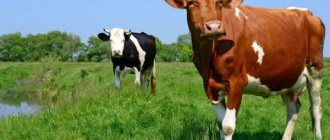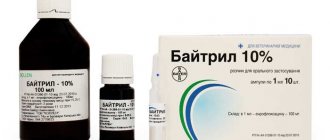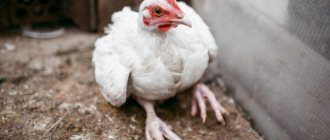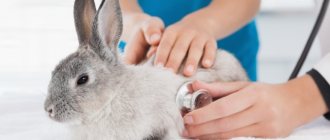Home / Eco life / Village life / Farming / Poultry farming / Chickens / Diseases / Chickens
Back
Published: 10/23/2017
Reading time: 11 min
0
2517
Diseases in broiler chickens often begin at a very young age due to the poor health of some chickens and their extremely rapid growth. Therefore, young broiler chickens are usually kept separately from adult chickens and from other breeds.
Young chickens are very susceptible to various types of infections, so those who become ill should be immediately isolated, and their droppings should be disinfected and not used for fertilizer in the area where the poultry is bred. Much attention should be paid to disease prevention and disinfection of premises.
- Why do broiler chickens sneeze and wheeze? Cold
- Mycoplasmosis
- Bronchitis
- Bronchopneumonia
- Colibacillosis
What kind of raucous sounds can a broiler make?
Normally, broilers should not wheeze. Large chickens may cluck hoarsely, which is due to the functioning of their vocal apparatus.
Such hoarse sounds, which are constantly present when the bird calls, are not accompanied by any additional symptoms.
Normally, broilers should not wheeze.
Pathological wheezing appears during breathing and is present in the bird, even when it is silent. There are also additional symptoms, which may include beak breathing, coughing, and discharge from the nose or eyes.
The bird needs treatment. Without therapy, broilers will die.
Interesting! Chickens cough, making a strange loud sound, reminiscent of a strangled, abruptly ending cry, which does not look like a bird's.
Housing conditions affecting bird health
Broilers are delicate birds and they cannot tolerate dampness, drafts, or cold in the chicken coop. If even one chicken sneezed or coughed, you need to pay attention to the condition of the room. It must be dry, including the litter. There should be no cold draft coming from the floor.
Heating lamps are placed so that there is heat near the feeder and in the far corner. Change the litter to fresh one. In a cramped room, it is necessary to provide ventilation without drafts.
If chickens are purchased from a large farm, they are already vaccinated against diseases common in the region. Then the adults will get sick first, and this will be a reason to vaccinate the livestock.
It is necessary to carefully examine the sick chicken. Perhaps he simply pecked at a large foreign body and it got stuck in the throat.
Why do chickens sneeze and wheeze?
Causes of strange sounds in adult chickens:
- cold;
- bronchopneumonia;
- Newcastle disease;
- goiter blockage;
- viral bronchitis;
- acute allergy – occurs infrequently.
Treatment must be carried out immediately after symptoms of the disease are detected. In hot weather, chickens often breathe with their open beaks, wheezing slightly. No therapy is required here.
Causes in broiler chickens
Chickens in the first month of life are susceptible to viral diseases and, in the absence of vaccination, get sick quite often, even with good maintenance.
Be sure to read:
The most common diseases of chickens, their symptoms and treatment. Photos of sick birds
The main causes of wheezing and sneezing are:
- aspergillosis;
- respiratory mycoplasmosis;
- colibacillosis;
- coccidiosis;
- Nostril blockage is a rare occurrence that can occur when chickens are fed sticky porridge.
In some cases, broiler chickens may begin to wheeze due to internal developmental defects.
In this situation, treatment is ineffective. A problem bird sometimes manages to gain slaughter weight, but more often it dies within 1-2 weeks.
Causes in adult broilers
Adult broiler chickens wheeze more often due to colds and helminthic infections. Unlike chickens, they are not so susceptible to infectious diseases, although they still cannot be ruled out.
Prevention
What should a poultry farmer do to prevent disease and death of chicks? He should purchase starter feed and preventative medications added to drinking water. They are usually offered by the seller, but you can purchase them at a specialty store. It is better to use starters within two weeks, subsequently replacing them with a grower or using a BVMK.
Compound feed starter
The second important preventive measure is compliance with zoohygienic standards for poultry keeping
Particular attention must be paid to the air temperature and humidity in the room. Dampness and cold weaken the immunity of chicks and create optimal conditions for the development of pathogenic microflora
In case of infectious bronchitis, clinically sick birds are isolated and sent for slaughter or disposal; their treatment is most often ineffective. Chickens wheeze, go blind and die.
Choose a medicine for colds, after which there are no restrictions on the use of meat or eggs. To prevent subsequent infections, the premises are disinfected, and the livestock is culled.
To prevent chicks from getting sick with colibacillosis, it is necessary to use starter feed, feed Baytril or another universal antimicrobial agent.
The occurrence of aspergillosis indicates a low production culture. This fungus develops due to gross violations of feed storage, unbalanced diet and poor zoo-hygienic conditions. Sick individuals are discarded; the pathology will not recur if the causes of its occurrence are eliminated.
We invite you to join our group on VKontakte or Odnoklassniki, where new articles are published, as well as news for gardeners and livestock farmers.
Possible diseases and their symptoms
There are many diseases of chickens that cause respiratory symptoms . All of them have additional symptoms that help make the correct diagnosis.
There are many diseases of chickens that cause respiratory symptoms.
Cold
Hypothermia causes colds and rhinitis more often in chickens, and sometimes in adult birds. The disease is not dangerous, but requires mandatory treatment.
Symptoms, in addition to wheezing and sneezing, are as follows:
- discharge of mucus from the nostrils;
- crusts in the nostril area;
- swelling of the eyes - sometimes only one side becomes swollen;
- general depressed state.
Treatment is with antibiotics. The bird is placed in a warm place, the eyes and nose are washed with chlorhexidine or calendula decoction.
Laryngotracheitis
A viral disease that causes inflammation of the respiratory tract. Young animals up to 4 months old are most often affected. Adult broilers suffer from pathology when there is severe dampness in the poultry house.
Laryngotracheitis
If left untreated, the mortality rate is up to 80%. Additional symptoms of the disease are swelling of the throat mucosa, white lumps in the throat and foam. Treatment is with antibiotics. The sick chicken is isolated.
Rhinotracheitis
A viral infection, often accompanied by an additional bacterial infection, in which the skin becomes inflamed and the head swells.
No specific treatment has been developed. Broad-spectrum antibiotics are used. The method of prevention is vaccination.
Infectious bronchitis
A viral disease that is more common in young birds. No specific treatment has been developed. Maintenance therapy is carried out. The sick bird is isolated. Vaccination protects against the problem.
Be sure to read:
What are the most common diseases of broilers, their symptoms and treatment
Bronchopneumonia
Develops as a complication of a cold or infectious bronchitis. The inflammatory process in the lungs causes wheezing, coughing and sneezing.
As a primary disease, it appears due to hypothermia, which is the cause of most non-infectious respiratory diseases.
For treatment, a sick chicken is isolated in a warm room and treated with broad-spectrum antibiotics.
Advice! The veterinary drug can be replaced with human antibiotics prescribed for pneumonia.
Mycoplasmosis
Bacterial infection transmitted by airborne droplets. The disease spreads rapidly from bird to bird.
Mycoplasmosis
Additional symptoms include swelling of the eyelids, weight loss, apathy and lack of appetite. Sometimes inflammation of the oviduct is observed. Mortality in broilers, even with therapy, is up to 30%. Treatment is with antibiotics.
Colibacillosis
Bacterial infection. In addition to wheezing and coughing, it is manifested by diarrhea, severe thirst and lack of appetite. Treatment with antibiotics is difficult.
Some broilers may still die.
Tuberculosis
Symptoms appear with severe damage. The disease has no cure. Sick birds are slaughtered and disposed of. In addition to pulmonary manifestations, depletion and yellowness of the ridge are noted.
Coccidiosis
Wheezing and sneezing develop due to mucus getting into the beak. The protozoan parasite penetrates the chicken's intestines, leading to severe damage to internal organs.
Urgent treatment is required with special veterinary drugs. A striking additional symptom is that chickens are diarrhea with blood.
Aspergillosis
A disease caused by mold. In addition to breathing problems, the pathology is manifested by alternating diarrhea and constipation, weight loss and unsteadiness of gait.
Disease caused by mold
In the initial stage it is treated with boric acid and iodine.
Escherichiosis
A contagious disease that, in addition to respiratory symptoms, is characterized by lethargy of the bird and diarrhea.
Blueness of the beak is often noted. After consultation with a veterinarian, antibiotics are used for therapy.
Colds
Hypothermia in the cold season and drafts in the chicken coop can lead to colds in chickens. Its main features include:
- swelling of the mucous membranes and inflammation of the respiratory tract;
- secretion of mucus (snot) and frequent sneezing;
- difficulty breathing, in which the bird breathes through an open mouth and wheezes;
- cough appears;
- chickens refuse to eat and become inactive;
- body temperature rises.
To prevent chickens from catching colds, the house should always be dry.
Particular attention should be paid to bedding and changed regularly. If the chickens are huddled together, they are most likely cold.
But if your pets still have a cold, then they should be treated at the first signs of illness. Otherwise, a simple cold can lead to complications and death of birds.
Cold treatment
First of all, you need to take the following actions:
- Sick individuals should be moved to a separate room, otherwise the entire herd will become infected.
- Ventilate the chicken coop.
- Treat the surfaces of the poultry house with freshly slaked lime, which is a good disinfectant.
- Replace the flooring with a new one and burn the old one.
- Rinse and disinfect drinking bowls and feeders with vodka.
They treat not only sick birds, but also healthy ones. First, streptocide is applied to the beak of chickens using cotton wool. At the second stage of treatment, the entire livestock is given the antibiotic levomethicin, the dose of which must be prescribed by a veterinarian.
If chickens are wheezing and sneezing, then you can get rid of these symptoms by inhaling essential oils or smoke bombs, which are sold at a veterinary pharmacy. Experts recommend using nettle decoctions as an anti-inflammatory agent and feeding them to birds.
Treatment of sneezing and wheezing in broilers
Therapy is carried out with veterinary drugs or home remedies.
Be sure to read:
Why and when do chickens molt and what to do, how long does molting last for laying hens?
Treatment with antibiotics
Antibiotic drugs are most often used for respiratory pathologies. Broad-spectrum drugs give quick results and do not subsequently affect the productivity of chickens.
Veterinary drugs or human antibiotics may be used. It is better to use specialized medications, as they are designed for poultry and work more effectively.
Important! Antibiotics from the pharmacy are usually given at the rate: 1 tablet per 1 head per day.
Traditional methods of treatment
Home remedies are used when antibiotics cannot be used. Broilers are given a solution of manganese, vodka, boric acid or iodine.
All these remedies are effective only in some cases and in some pathologies they only cause harm. At home, if treatment with veterinary drugs is not possible, it is recommended to slaughter the bird.
General rules for keeping broilers when sick birds appear
If a sick bird is detected in the poultry house, it is immediately isolated. The litter is replaced and, if possible, antiseptic treatment is carried out, ideally - aeration of the chicken coop.
The diet of healthy chickens is enriched with vitamin and mineral complexes to improve immunity. When an infectious disease is detected, healthy chickens are given medications in prophylactic doses.
General rules for keeping broilers when sick birds appear
If while feeding you notice a bird with unusual behavior for the flock, take a closer look. If the feathers are ruffled, the appearance is sloppy, the posture is dejected, it’s time to put the broiler in an isolation ward and watch him. At the same time, analyze the living conditions, do sanitary cleaning in the chicken coop and consult with a specialist. If broilers are sneezing and wheezing, the doctor will determine what to treat. You should follow his recommendations in order to preserve the livestock.
Treatment of sneezing and wheezing broilers - video
- Author: Maria Sukhorukikh
Rate this article:
- 5
- 4
- 3
- 2
- 1
(0 votes, average: 0 out of 5)
Share with your friends!
Disinfection of the chicken coop
If an infectious disease is detected on a farm, quarantine is established for a period of 2 to 6 months. The poultry farmer must follow the recommendations of the Sanitary and Epidemiological Supervision Authority. What to do with sick birds? They are slaughtered and the carcasses are disposed of. Conditionally healthy chickens are treated, and the poultry house is disinfected.
Treating a barn with iodine chloride
Procedure:
- First, the litter is removed and burned.
- The floor is cleared of any remaining droppings and feathers.
- Litter and bedding are disinfected using the biothermal method in a dung storage facility.
- Wet and aerosol disinfection is carried out.
After identifying a case of infectious bronchitis on the farm, the equipment is treated with a 2% sodium hydroxide solution with a two-hour exposure. The area around the poultry house and the paddock are disinfected with caustic alkali at a concentration of 3% in a one-percent formaldehyde solution. For wet treatment of the walls and floor of the barn, one of the following solutions is used (composition consumption - 1 l/m2):
- formaldehyde (2%);
- slurry of freshly slaked lime (20%);
- formalin plus creolin in a 1:1 ratio in the form of an aerosol at a dosage of 5 ml/m3.
Attention! The room is treated every 2 days, the yard - once a week.











